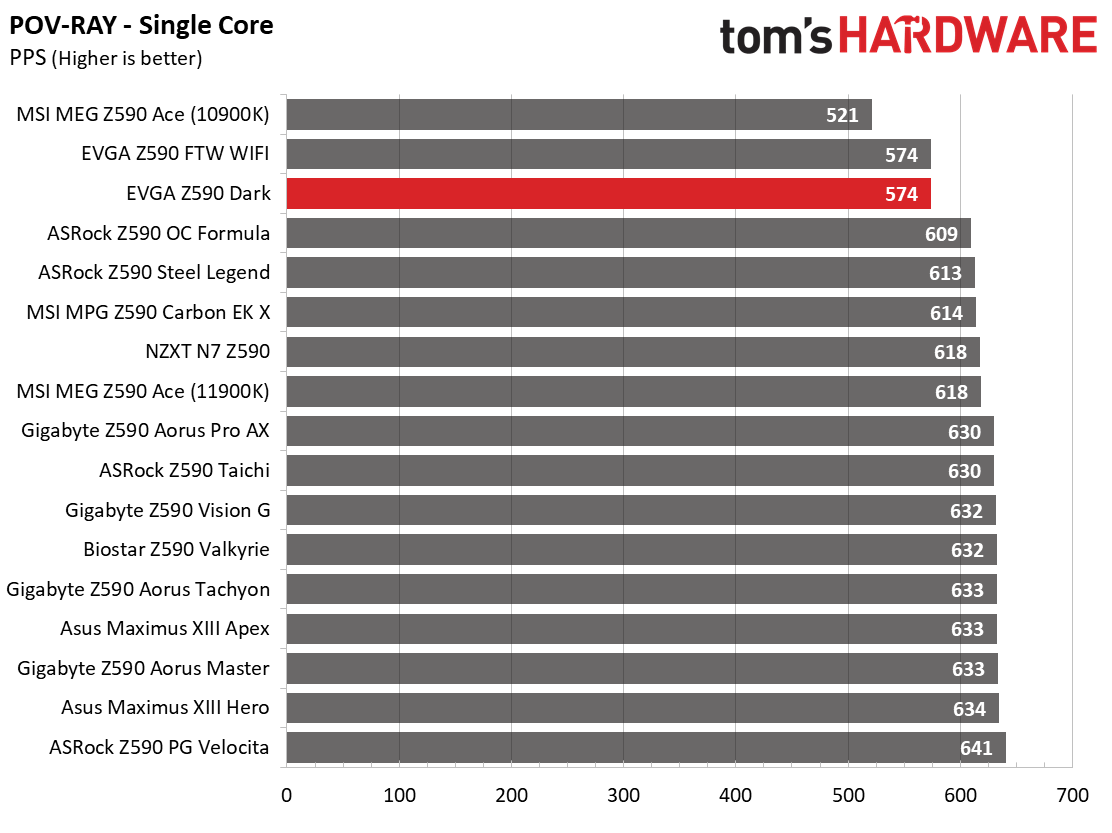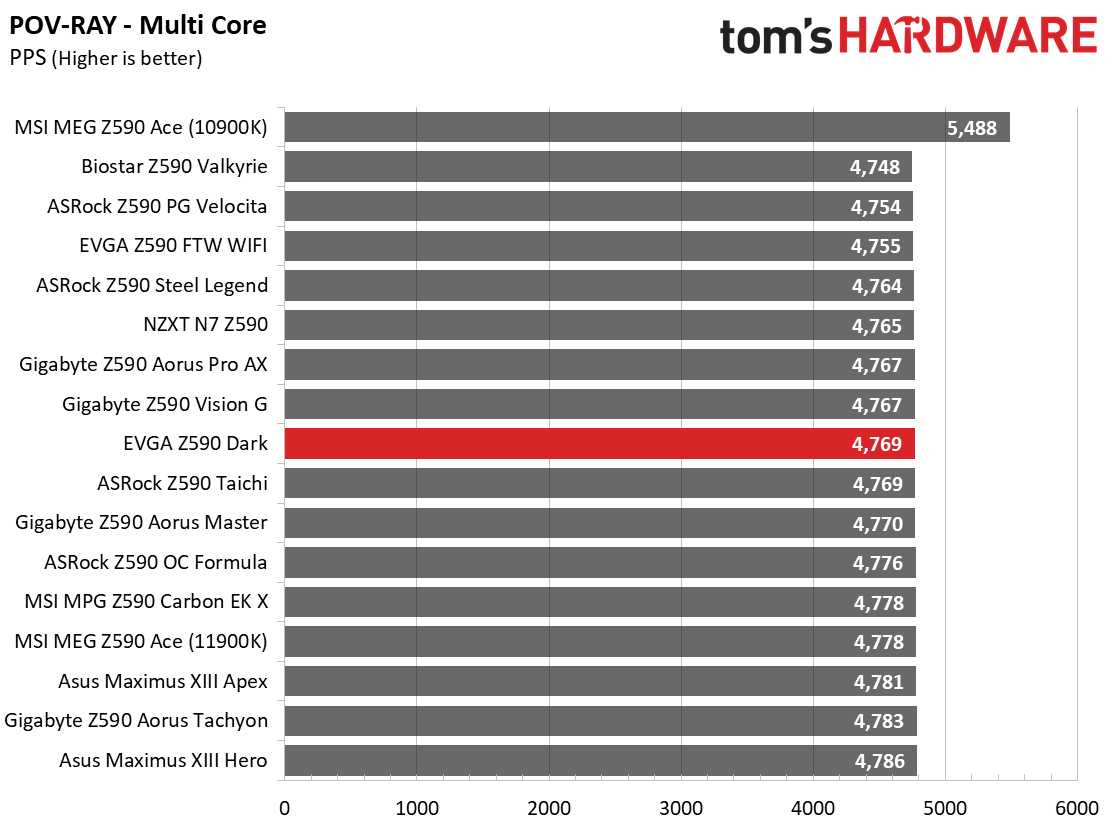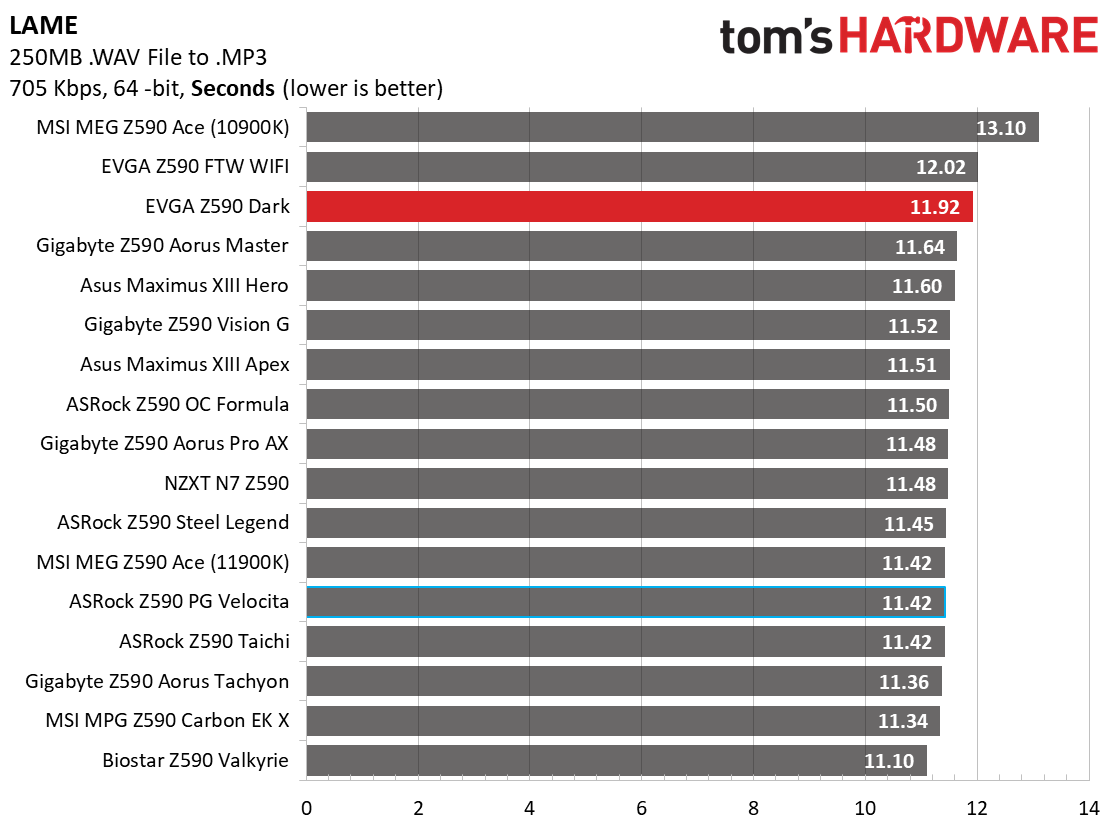Why you can trust Tom's Hardware
Benchmark Results
Our standard benchmarks and power tests are performed using the CPU’s stock frequencies (including stock Thermal Velocity Boost), with all power-saving features enabled. Optimized defaults are set in the BIOS and the memory set using the XMP profiles. For this baseline testing, Windows is set to the balanced power plan.
Synthetic Benchmarks
Synthetics are a great tool to determine if a board runs out of spec, as identical settings should produce similar performance results. Advanced memory timings are the one place where motherboard makers can still optimize for either stability or performance, though, and those settings can impact some testing.





















The EVGA Dark did OK overall here, just like the Z590 FTW WIFI. Some tests (Cinebench Single Core, 7Zip Compression, PCMark 10 Suite) were slower than the average. In other tests, it compared well with its peers. In most cases, you’d be hard-pressed to see a difference unless you timed/benchmarked the result.
Timed Applications




LAME testing showed the EVGA Dark as the second-slowest Rocket Lake-based result at 11.92 seconds (only the FTW WIFI was slower). On the other hand, the Corona test came in at 84 seconds, which is about average, and three seconds behind the fastest boards. Last, the x264 Handbrake test ran in 184 seconds or right around average. x265 tests took 491 seconds to complete, slightly below the average.
3D Games and 3DMark




We’ve recently updated our game tests to F1 2020 and Far Cry: New Dawn. The games are run at 1920x1080 resolution using the Ultra preset. As the resolution goes up, the CPU tends to have less of an impact. The goal with these settings is to determine if there are differences in performance at the most commonly used resolution with settings most people use or at least strive for.
In both 3DMark and our real game testing, the EVGA Dark did well, coming second behind only the FTW WIFI. In Far Cry, it was grouped with the slower results at 139 Frames Per Second (FPS), while in F1 2020, the 209 FPS result was right on average. However, all gaming results are pretty close, so it would be tough to notice a difference outside of benchmarks.
Power Consumption / VRM Temperatures

We used AIDA64’s System Stability Test with Stress CPU, FPU and Cache enabled for power testing, using the peak power consumption value. With Rocket Lake, we need to disable AVX-512 instruction sets; otherwise, temperatures are out of control at stock speeds on some boards. The wattage reading is from the wall via a Kill-A-Watt meter to capture the entire ecosystem. The only variable that changes is the motherboard; all other parts are the same.
Get Tom's Hardware's best news and in-depth reviews, straight to your inbox.
On the power consumption side, the EVGA Z590 Dark was average overall. At idle, the Dark used 85W, which is one of the higher values we’ve seen so far. Load wattage peaked at 252W, one of the lower values we’ve seen (and this is running at 4.8 GHz as well). Overall, this is a good showing but the board certainly isn’t the most efficient at idle.




The EVGA Dark’s 90A MOSFETs, along with its shiny copper finned heatsink and VRM fans, worked well, efficiently managing our Core i9-11900K CPU at both stock and while overclocked. The VRM peaked at 47 degrees Celsius when running at stock speeds and matched our high-end boards (most passively cooled). When overclocked, the Dark WIFI kept the VRMs just under 50 degrees Celsius, again right in the area of the other overclocking boards. In short, you have nothing to worry about on this front, even when overclocking.
Overclocking
Overclocking on the EVGA Dark was just as easy as on the FTW WIFI. We set voltages, disabled any TVB boost(s) and any Adaptive boost, so the clocks hold and are unaffected by these automated features. The BIOS is laid out nicely, with almost everything you need in one menu heading. That said, at the time of testing, voltages were off in CPUz, but Eleet X1 was accurate. If you’re interested in seeing accurate voltage, use the ProbeIt feature and a multimeter.
When overclocking the i9-11900K, we decided to do so by testing without AVX-512 instructions. When you unlock all of the power limits, you’re thermally limited, with the CPU reaching 100 degrees Celsius in several seconds. Since every board is different in following (or not following) Intel specifications, we’ve removed that variable. The bottom line is that if you need to use these instructions, you’ll need to set a significant offset compared to non-AVX-512 loads. To that end, we settled on a 5.1 GHz overclock at around 1.3V. Our CPU uses around 225W in this configuration, which lands between stock power use (195W) and AVX-512 power use (~265W) and is the end of the line due to thermal constraints.

On the memory front, the Z590 Dark worked with our DDR4 3600 sticks at a 1:2 ratio (Gear 2) and didn’t have any issues with the DDR4 4000 kit (also Gear 2). I was surprised to see it default to the 1:2 ratio at this low of speed. Many other boards stick to 1:1 through DDR4 3600. AIDA bandwidth and latency tests put the Dark in the middle of the pack overall, with writes the fastest we’ve recorded so far. Read and copy landed in the middle of the pack, while latency was slower than average, at least in part due to the gearing. Again, we had no issues getting these kits to work on this board and BIOS for our limited memory testing.
Final Thoughts
The EVGA Z590 Dark arrived on the scene later than most Z590 competitors, but I feel the wait was worth it. Like the Z590 FTW WIFI, the Dark’s appearance is much improved, along with the hardware. While the looks have certainly improved, the company didn’t forget about premium hardware or the overclocker either. Priced at $599.99 on the EVGA website, the board includes high-quality power delivery, plenty of storage options (3x M.2, 8x SATA, 1x U.2), a USB 3.2 Gen2x2 Type-C port, dual Intel 2.5 GbE plus integrated Wi-Fi 6, 100% copper heatsink with active cooling, and a unique look with the socket rotated 90 degrees.
On the performance front, the results varied depending on the test. We saw solid results in Handbrake x264 and most of the PCMark 10 suite, but some others fell short due to the AVX offset not allowing the CPU to boost quite as freely. That said, in most tests, the difference in performance was slight and not something to worry about, especially if you plan on overclocking this board (which you should, since that’s what many of its features are aimed at).
That said, although the looks have improved, aesthetics are still not quite where most other $600 motherboards are. While I feel EVGA’s board looks better than the ASRock Z590 OC Formula, it isn’t quite up to the clean look of the Asus and Gigabyte overclocking boards that are similarly priced. Another area where I’d like to see improvement is additional USB ports on the rear IO -- at least eight out here, regardless if there are additional headers for the chassis. The Wi-Fi is also worth calling out; where the other comparable boards are running 6E devices, the Dark is Wi-Fi 6. This isn’t a big deal for most users, but worth noting as a difference between these comparable priced motherboards.
Competition for the Dark is fierce and includes the ASRock Z590 OC Formula ($579.99), Asus ROG Maximus XIII Apex ($599.99), and the Gigabyte Z590 Aorus Tachyon ($529.99). MSI offers the MEG Z590 Unify for $379.99, which is an attractive lower-priced option. We know about the Wi-Fi 6/6E differences and only the Apex includes the latest and greatest audio codec, along with the most M.2 sockets (four versus the rest with three). Power delivery is different between these overclocking focused boards, but all we tested easily handled our CPU when overclocked. Appearance also plays a part in motherboard selection, and while we like the improvements we’ve seen in the Z590 motherboards, some may find the boards with additional RGB lighting and shrouds fit their build theme better.
Overall, we like how EVGA updated the EVGA Z590 Dark. You get a much-improved and unique aesthetic, robust power delivery and plenty of storage options, including a rare-on-consumer-motherboards U.2 port. If you require Wi-Fi 6E or want the latest and greatest audio, you’ll have to look elsewhere or use an add-in card, but those are hardly deal-breakers. If you have $600 to spend on an overclocking-focused build, EVGA’s flagship Z590 Dark deserves to be on the short list.
MORE: Best Motherboards
MORE: How To Choose A Motherboard
MORE: All Motherboard Content

Joe Shields is a staff writer at Tom’s Hardware. He reviews motherboards and PC components.
-
BTM18 Already sold out ?Reply
https://www.evga.com/products/productlist.aspx?type=1&family=Motherboard+Family&chipset=Intel+Z590 -
deesider Is this not a weird MB?Reply
It's a massive E-ATX board, but only has 2 usable PCIe slots and 2 DIMM slots, for $600, with OK performance. -
btmedic04 Replydeesider said:Is this not a weird MB?
It's a massive E-ATX board, but only has 2 usable PCIe slots and 2 DIMM slots, for $600, with OK performance.
This board isnt intended to be a daily driver, thats the FTW's job. The Dark is intended to be used with sub zero cooling for world record attempts, which the review failed to touch on.
That socket area is very busy with all of those SPS and I dont envy the people who need to insulate that area for LN2 pot usage -
Co BIY Are there really that many Extreme overclockers in the world?Reply
And how many of those don't already have their Z590 board?
Inclusion of U.2 is interesting to me - Can I get faster acccess with U.2 or are all the overclockers IT pros with awesome U.2 (or new Optane) drives just laying around ?
Bare copper heat sink is a good look though. A little steam punk, a little "electrical hotrod".
